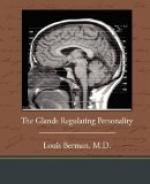3. There is no absolute masculine or absolute feminine. The ideals of the Manly Man and the Womanly Woman were erected by the blind ignorance of the nineteenth century illusionists, and a line drawn to cleave them. But indeed biologically there exists every transition between the masculine and the feminine. The explanation of these different sex types consists in the different admixtures of the internal secretions possible and actual. When we speak of the feminine we really mean the predominantly feminine. And when we speak of the masculine, we mean the mainly masculine. Between, all sorts of transitions are possible and occur.
Man in relation to the internal secretions we have considered in reviewing the interstitial cells. To him, we shall return later. Let us turn now to that fascinating subject of the ages, Woman. What produces and maintains the Feminine?
THE CAUSE OF SEX
To all appearances, that inscrutable simplest of living things, the fertilized ovum, beginning of the human, starts bisexual, double sexed, both masculine and feminine, or perhaps neither masculine nor feminine. Then a form develops. Then within that form a patch of cells arise which the microscopist recognizes as the forerunners of the male or the female reproductive cells. Then some more development. And at birth, sex is definitely settled, as far as the reproductive organs are concerned.
Our knowledge here, as everywhere, is still fragmentary. Statistical reviews seem to show that in times of stress, war, famine, pestilence, more boys are born than girls. But that is neither here nor there. It sheds no further light on the subject. Monosexuality is a distinction of the human species: the sexes are pretty clearly differentiated. In some animals, such as some worms, there is a bisexuality of the individual. There are present the reproductive organs of both sexes, capable of impregnating other individuals as well as of being impregnated. In some of these, even self-impregnation may occur. This is the condition of hermaphroditism.
But the higher up one goes in the scale of evolution, the greater becomes the distinction between the sexes. Anatomic hermaphroditism becomes a rare anomaly. Life appears to have perfected this trick of separate sexes, sex specialization, in short, for the sake of the efficiency which goes with specialization.
When a germ cell divides, its nuclear material breaks up into segments known as chromosomes. Now it has been found, for example in the case of the common squash bug, anasa tristis, that there are 22 chromosomes in the female, and 21 in the male. In the female two of these are visibly different from the rest, while in the male there is one odd one, the remaining 20 being like the corresponding 20 of the female. Before the germ cell becomes fit to mix with a germ cell of opposite sex, in the process of fertilization,




